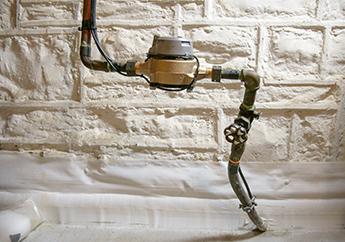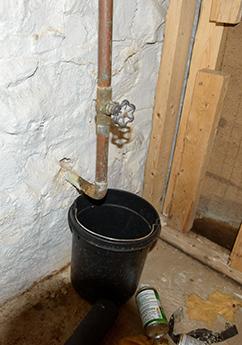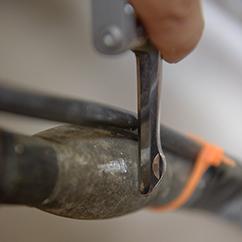Division of Environmental Quality Director: Art Goodin
Service lines are the pipes that connect a building's plumbing to a public drinking water system, carrying water from the water main to the home or building. Even though the federal government banned using leaded pipe and solder in new plumbing systems built after 1986, lead pipes can still be found in older cities. The lead ban for Missouri became effective Jan. 1, 1989. Old lead service lines can be made of pure lead, or connected with lead solder (wipe joint).
The service line to your building or home could be made of plastic, copper, PEX, HDPE, galvanized steel, lead or a combination of materials. To determine what your service line is made of, grab a refrigerator magnet and a key or coin, and follow the steps below. If you cannot locate your water meter or service line, or it is unclear which category applies to the pipe, you can call your public water system for assistance.
Locate the Water Meter

Buildings or homes on public water systems have a water meter, which could be located either inside or outside of the structure. The actual water meter will have a dial that reads "gallons." If it reads "cubic feet" or "kilowatt hours," that is either a natural gas or electric meter.
Find the Service Line
- If the water meter is located inside, the service line will enter the building or home a few feet underground before coming through the wall or foundation and connecting to the water meter (Fig. 1).
- If the water meter is located outside, take the shortest path from the water meter to the building or home. This is normally where the service line enters the structure. Go inside and locate the service line.
The service line should be a .75-inch to 1-inch pipe coming from either underground or through the foundation floor or wall, with an attached shutoff valve that looks something similar to the (Fig. 1) photo. Focus on the section of pipe where the service line enters the building. Is that section of pipe made of plastic or metal?

Plastic Pipe
If the pipe is plastic, that is good. It indicates that your service line may not be made of lead.
Plastic pipes may be many colors: white, blue or black are common (Fig. 2). Most people are familiar with plastic and can easily identify it. Although the service line entering your home or building is plastic, there may be connectors or repairs made of lead that are not visible.

Metal Pipe
If the pipe is metal, it could be copper, galvanized steel or lead. You can narrow down which metal with a few more tests.
What Color is the Pipe?
Using the key or coin, scratch the metal pipe close to where it enters the house through the wall. What color is the pipe?
- Orange-brown, like a shiny penny: The pipe is probably made of copper (Fig. 3)
- Silver or Gray: The pipe could be galvanized steel (Fig. 4) or lead (Fig. 1)
Copper Pipe
Copper pipe is orange-brown and shiny like a new penny when scratched. Old copper may be weathered and have a green tint, or it may be painted. This is why you may need to scratch the copper pipe.
Is the Silver or Gray Pipe Magnetic?
On the same section of pipe, touch the refrigerator magnet to the metal pipe. Does the magnet stick?
- Yes: The pipe is probably galvanized steel
- No: The pipe is more than likely made of lead

Galvanized Steel Pipe
Galvanized steel pipe is not great. If there are lead connectors or lead service lines upstream of galvanized service lines, lead leached from them can flow downstream and collect on the galvanized coating. Galvanized steel pipes can periodically release this lead, even after the lead piping is removed. Galvanized pipe has theaded fittings (Fig 4). A magnet will stick to a galvanized steel pipe.
Lead Pipe
If the pipe is silver/ gray and not magnetic, was it hard or soft when you scratched it?
- If it was hard, the pipe is probably lead
- If it was soft, the pipe is made of lead

If the pipe has a wipe joint — looks like a snake that has eaten something (Fig 5) — the pipe is made of lead.
To confirm, call your water utility. If it is lead, here is what you can do:
- If you want to get a sense of how lead might be affecting your water, request a test from your water utility. You can order tests online, but they are not as reliable as testing from a certified laboratory. Releases of lead from a lead service line or galvanized service line is sporadic. One good test does not mean there is no lead in the water.
- Consider replacing your service line if it is lead or galvanized. Call a local plumber to get an estimate. Your water utility might also provide recommendations.
- If replacing pipes is not an option, consider installing a water filter that is certified to remove lead. The filter should read “NSF/ANSI Standard 53” on the package. If it has been a few hours since the tap was last used in the building or home, let the water run for five minutes before it is used. This flushes out water that has been sitting in the pipes.
To help you identify your service line material, print out a copy of the department's How to Identify Your Service Line Material flyer, which has color photos of scratch tests on metal pipe.
*All credited photos are from the Missouri Department of Natural Resources, in cooperation with Missouri American Water Co.
Nothing in this document may be used to implement any enforcement action or levy any penalty unless promulgated by rule under chapter 536 or authorized by statute.
For more information
Public Drinking Water Branch
Water Protection Program
P.O. Box 176
Jefferson City, MO 65101-0176
United States
